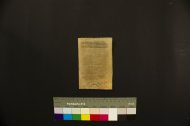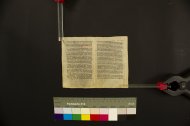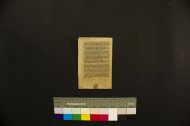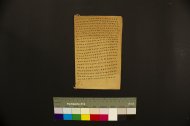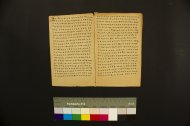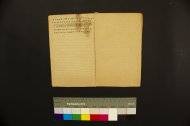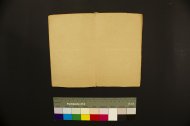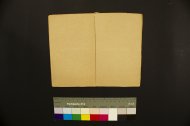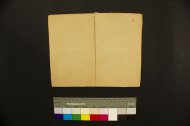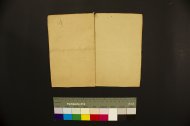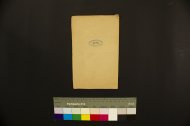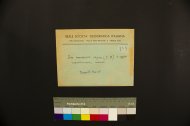The item consists of two separate units, labelled SGI 248.C and SGI 248.D. Both of them came together at the Società Geografica Italiana in a large envelope, bearing the following inscription in Italian: “Due manoscritti etiopici (C.D) di soggetto rispettivamente indicato”.
SGI 249.C
|
Shelfmark |
SGI 249.C |
|
Owning institution |
Società Geografica Italiana, Rome |
|
Typology |
Quire |
|
Copying date |
19th cent., based on paleography |
|
Title |
Divinatory texts |
|
Subject |
Divination, Magic, Old Testament |
|
Language |
Gǝʿǝz |
|
Short description of the content |
F. 1r: Short quotations from the Psalms Text: ውስተ፡ አፍላገ፡ ባቢሎን፡ ህየ፡ ነበርነ፡ ወበከይነ። (Ps 136.1) ኀቤከ፡ እግዚኦ፡ አንቃዕዶነ፡ አዕይንተነ፡ ዘትነብር፡ (Ps 122.1) ውፍታሕ፡ (sic) ሊተ፡ እግዚኦ፡ እስመ፡ አንሰ፡ በየውሃትየ፡ አሐውር፡ (Ps 25.1) እግዚአብሔር፡ ያበርህ፡ ሊተ፡ ያድኅነኒ፡ ምንትኑ፡ ያፈርሃኒ፡ (Ps 26.1) ይትኃፈሩ፡ ወይኅሰሩ፡ ኅቡረ፡ እለ፡ ይፈቅዱ፡ ያእትትዋ ፡ <ለነፍስየ ፡> (Ps 39.19). F. 1v: End of an unidentified divinatory text, probably a computus in 34 divinatory formulas for prediction. The text is incomplete: only the end is preserved. Incipit: ]እ፡ ትረክብ፡ ሠናየ። ፳፱ሐ<፡> በዘይሤኒ፡ ወኢይሤኒ፡ ይሤኒ፡ ለከ። ፴ሐ<፡> በጉባዔ፡ ዝርዋን፡ ወይትራከቡ። ፳፩ሐ<፡> በንዋይ፡ ይትረከብ፡ Ff. 1v–2r: Computus called Ǝlḥut nǝguśä andases (“Piscis, the king of andases (?)”), in 34 divinatory formulas for prediction. Incipit: ፲፪እልሑት፡ ንጉሠ፡ አንዳሴሰ። ፩በተስፋ፡ ወጸኒሕ፡ ትረክብ፡ ዘተሰፎከ፡ ወጸናሕከ። ፪በዓፀባ፡ ሀሎ፡ ዓፀባ፡ ወቀርበ፡ ፍጻሜሁ። ፫በሙቁሕ፡ ቀርበ፡ ፀዓቱ። ፬በተሣይጦ፡ ርስት፡ ኢይሤኒ፡ ለከ። ኅድግ። Ff. 2r–v: Computus called Ḫǝbrätä qalat (“Concordance of the words”), in 9 divinatory sentences. Incipit: ኅብረተ፡ ቃላት፡ በዘተአምር፡ ወትጤይቅ፡ ለእኩይ፡ ወለሠናይ፡ ዘይትፈታሕ፡ ዘይነዲ፡ ወዘይብዕል፡ ዘይመውት፡ ወየሐዩ፡ ስም፡ ወእም፡ ወስመ፡ ሀገር፡ በ፱ግጽ። ፩ፍቅር፡ ምስለ፡ ኵሉ፡ ነገሥት፡ ወመኳንንት፡ |
|
Writing material |
Sheep parchment |
|
Outer size of the textblock |
123 x 78 mm |
|
Number of folia |
2 |
|
Blank folia |
– |
|
Binding |
The manuscript consists of a single unbound bifolium. |
|
Sewing |
– |
|
Sewing pattern |
– |
|
Quires |
1 |
|
Quire marks |
– |
|
Layout |
1 column |
|
Number of lines per column |
30 |
|
Ruling |
Blind ruling, from inside to outside. Lines are written above the ruling. |
|
Ruling pattern |
Nosnitsin 1 |
|
Scribe |
Unknown |
|
Colophon |
– |
|
Additional notes |
– |
|
State of preservation of the textblock |
Very good. |
|
Provenance and history |
Unknown provenance. The manuscript came into possession of the Società Geografica Italiana at some time before 1932, for it is mentioned in Silvio Zanutto’s Bibliografia etiopica (1932). It came in all likelihood together with MS SGI 249.D. |
SGI 249.D
|
Shelfmark |
SGI 249.D |
|
Owning institution |
Società Geografica Italiana, Rome |
|
Typology |
Quire |
|
Copying date |
19th century, based on paleography |
|
Title |
Itinerary in the land of Gibe and Guduru |
|
Subject |
Journey report |
|
Language |
Amharic |
|
Short description of the content |
Ff. 1r–3v: Journey report in the land of Gibe and Guduru Incipit: በ፲፰፻፸፬ዘመን፡ በት<ኅ>ሣሥ፡ በ፯ቀን፡ ተወጨጨ፡ ተነሳን፡ ተወጨጨ፡ ተነስተን፡ አዋሻ፡ አደርን፡ ተአዋሽ፡ ተነስተን፡ ኪኵ፡ አደርን፡ ተኬኵ፡ ተነስተን፡ ጨፌ፡ ጐላ፡ ተጨፌ፡ ጐላ፡ ተነስተን፡ F. 3v: Another journey report. The text is incomplete: it consists of few lines only. Incipit: በዘመነ፡ ማርቆስ፡ በት<ኅ>ሣሥ፡ በ፯ቀን፡ ወጥተን፡ በሰኔ፡ በ፲፱ቀን፡ እቢታችን፡ |
|
Writing material |
Paper |
|
Outer size of the textblock |
172 x 107 x 1 mm |
|
Number of folia |
8 |
|
Blank folia |
4r–8v |
|
Binding |
The manuscript is bound by means of two strips of parchment passing at the top and at the bottom of the only quire. |
|
Sewing |
Two S-twisted threads of vegetal origin |
|
Sewing pattern |
– |
|
Quires |
1 |
|
Quire marks |
– |
|
Layout |
1 column. |
|
Number of lines per column |
21–23 |
|
Ruling |
The manuscript is unruled. |
|
Ruling pattern |
– |
|
Scribe |
Unknown |
|
Colophon |
– |
|
Additional notes |
– |
|
Decoration |
– |
|
State of preservation of the textblock |
Good. |
|
Provenance and history |
The journey report on ff. 1r–3v refers to December 1881. The text was seemingly written soon later. The manuscript came into possession of the Società Geografica Italiana at some time before 1932, for it is mentioned in Silvio Zanutto’s Bibliografia etiopica (1932). It came in all likelihood together with MS SGI 249.C. |


